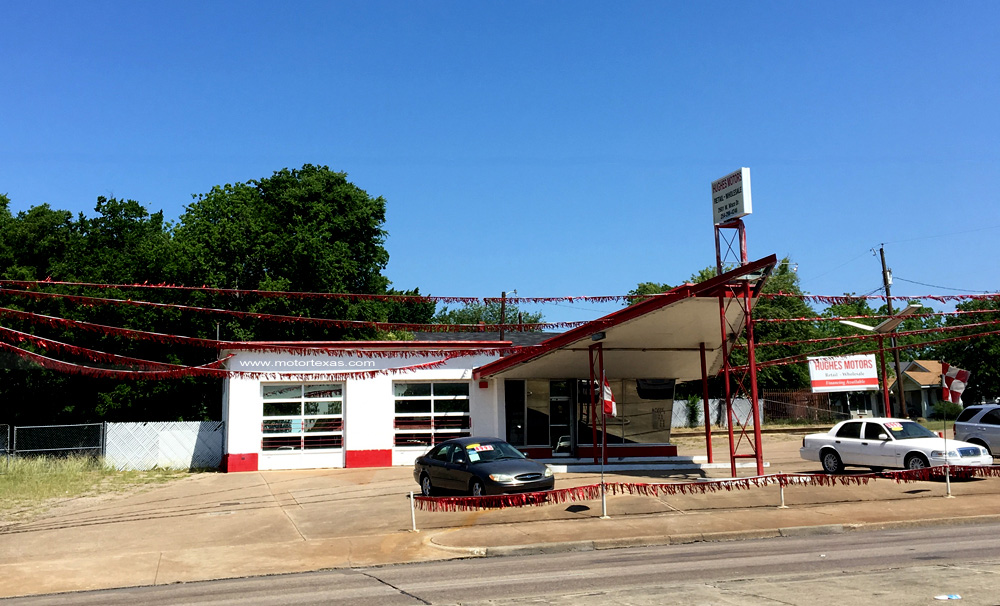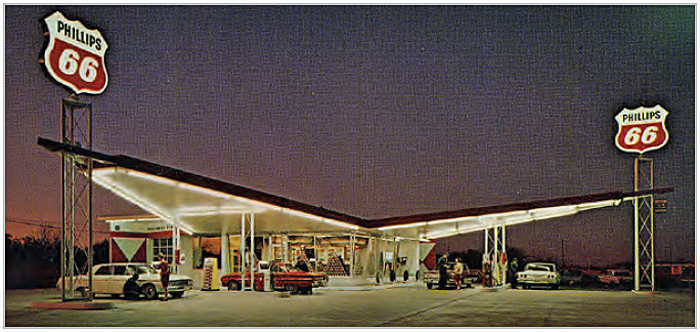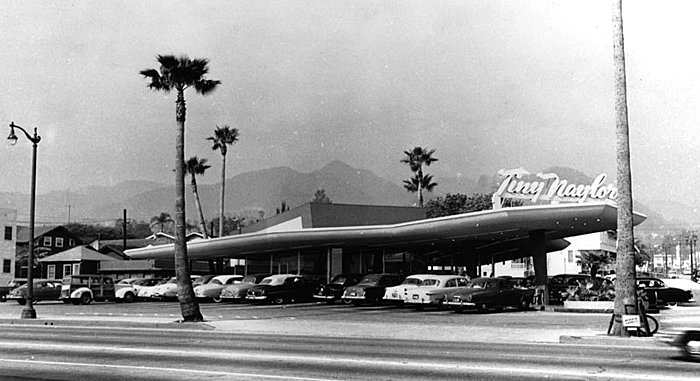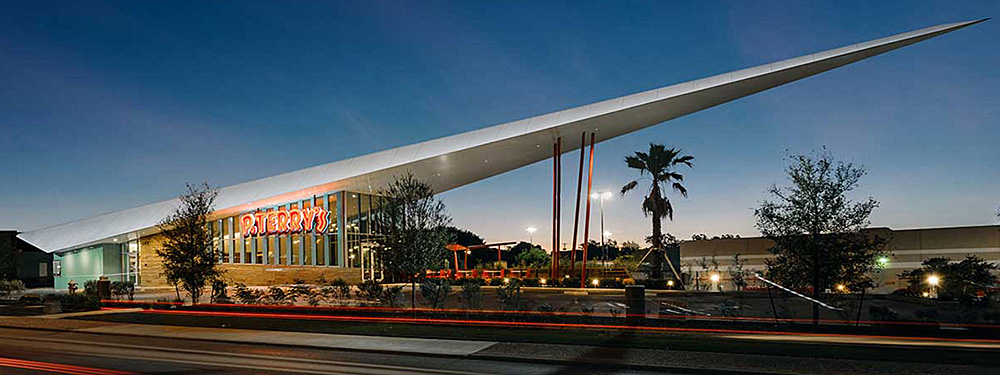Iconic Googie Gas Station in Waco
By: James Wilder
Ignored by thousands of busy motorists daily, this former gas station in Waco can be traced to an architectural movement that began in California in the 1940s. Read on to learn how iconic this gas station really is!
Former Phillips 66 Service Station in Waco

This architectural treasure is a former Phillips 66 service station. It's located at 2601 W Waco Drive, Waco, Texas.
It’s not just a service station, it’s an oasis of cool. A place to refuel. Step back in time and let the professionals fill your tank, check your oil, and wash your windshield. Stretch your legs and admire your tail fins. You'll be back on the road in no time.
This brilliant red and white service station was constructed in 1964, the same year the Ford Mustang was introduced and the government mandated seat belts for every car.
Phillips Petroleum used this modern architectural style on their service stations between 1960 and 1970. The design was inspired by an architectural trend that started in California, in the 1940s.
The eye-catching architectural features of these Phillips 66 stations were the upwardly projecting triangular canopy, full glass office enclosure, glass garage bay doors and bright lights that accent the canopy. The lights underneath the canopy flooded the area with light and gave customers a sense of security. And of course, brought attention to the skyward aimed canopy, a brilliant use of architectural style to serve as distinctive branding.
The glass walls of the service office angled out and upward. This not only looked cool, but served a purpose. The angled class deflected car headlights, making it easier to see into the office at night.
Now, hop in the time travel machine and lets cruise over to Bartlesville, Oklahoma and find out a bit about the man that designed these groovy gas stations!
Clarence Reinhardt - Architect on a Mission

Clarence Reinhardt merged California drive-in design into the new Phillips 66 service stations of the 1960s.
Clarence Reinhardt was an architect at Phillips Petroleum, in Bartlesville, Oklahoma. His career at Phillips began in the 1930s, and his specialty at Phillips was gas station design.
We all know the 1950s was a special decade. Car culture was accelerating and businesses were scrambling to get a piece of the action.
In 1951, Phillips Petroleum sent Reinhart on a fact-finding mission some fifteen-hundred miles west to Los Angeles, California. Phillips wanted to explore the possibility of increasing profits by integrating drive-in features into a new gas station design.
After returning from California, Reinhardt reported what he thought was the key to success. The most popular drive-ins had bold eye-catching architecture. He mentioned specifically a drive-in called Tiny Naylors.
At the time of Reinhardt's visit, this architecture didn't have a name to distinguish it from modern architecture. However, a few years after his visit, an architectural writer used the term "Googie" in an article that was critical of the style.
As you will see, the new Phillips 66 gas station design bears a striking resemblance to Tiny Naylor's.
What is Googie Architecture

Tiny Naylor’s was built in 1949. The drive-in was located at the corner of La Brea and Sunset Boulevard in Hollywood. It is a classic example of Googie architecture. Unfortunately, it was demolished in 1984.
What is Googie Architecture? Simply stated, Googie architecture is a form of mid-twentieth century modern architecture. It was influenced by car culture, jets, the Space Age, and the Atomic Age. The style originated in Southern California during the 1940s and continued into the mid-1960s.
Googie architecture was popular among businesses such as drive-ins, motels, coffee houses and gas stations, because it had a clear goal - grab the motorist's attention! It did so by being bold, modern, and very, very hard to miss.
Douglas Haskell, a writer and editor, coined the term Googie in an article he published in House and Home Magazine, in 1952.
The name Googie actually comes from a coffee shop in Los Angeles, California, called Googie's. Haskell used the name of this coffee shop to represent the architecture as a whole. It turned out to be a smart move for Haskell, because the name stuck. Googie's was a name most Californians easily recognized, since it was a well known restaurant and was frequented by celebrities such as James Dean.
Googie’s was demolished in 1989. But the style lives on!
Googie Architecture Revival

P. Terry's Burger Stand at 5701 N Interstate Hwy 35, Austin, TX. Image Credit: P. Terry's
Buildings can be demolished, but ideas can live on forever. That’s the case with Patrick Terry.
Patrick Terry grew up in Abilene Texas. He had fond childhood memories of a burger joint called Mack Eplen’s. In fact, Patrick was so fond of this business he had dreams of building his own. And that he did, big time I must a say.
Patrick Terry, along with his wife Kathy, opened the first P. Terry's on July 5th, 2005 at the corner of South Lamar and Barton Springs in Austin.
All P Terry's hamburger stands adhere to the Googie architectural style. However they each have their own distinctive character.
Each of the P. Terry buildings were designed by Michael Hsu Office of Architecture.
There are currently fifteen P. Terry’s in Austin and one in San Marcos.
More Groovy Attractions
Right across the street from the Waco Phillips 66 gas station is Kim's Diner. Kim's is a fifties style diner serving up burgers and shakes. They also have a waco monthly car meet on Saturday night, weather permitting.
If you are planning a trip to Waco, you might want to check out my Waco Attractions for Auto Enthusiasts guide. It's a simple one page list of suggested Waco attractions geared for auto enthusiasts.
I should also note, the first Phillips 66 station in Texas was built in McLean, Texas. It still stands as a restored historic building and Route 66 attraction.
Summary
Googie is still around us, but it’s original artifacts are fading quickly. Thankfully we have enthusiasts like Patrick Terry that have a passion for this automobile inspired architecture.
As with all the articles I write about historic buildings, it is my goal to raise awareness and my hope is always that these buildings will be appreciated and restored, rather than torn down.
You can help raise awareness to! All you have to do is share this article. Simple.